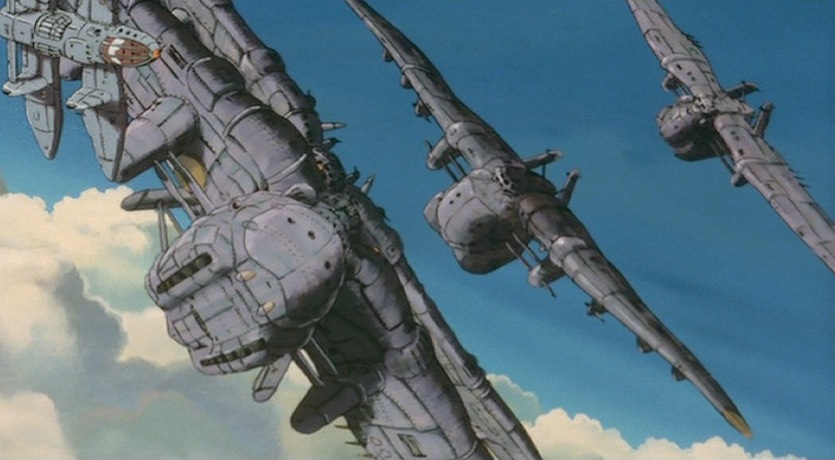The steampunk aesthetic is one that has rightfully drawn a lot of attention. The word draws to mind images of intricate clockwork and high Victorian fashion. There are a number of excellent posts on this blog where you can see exactly what I’m talking about. This is the form that the steampunk genre has taken in popular Western culture, but other artists have taken the aesthetic in unique directions that have an entirely new feel. One such artist is beloved Japanese filmmaker Hayao Miyazaki, whose worlds are constantly populated by fantastical steampunk aircraft. My idea for my upcycle project is to build a small model airship out of cardboard, in the style of Miyazaki’s films.

Miyazaki’s second film, and the manga on which it was based (also created by Miyazaki), set a precedent for the animator’s fascination with aircraft. The world of Nausicaä is populated by a varied cast of airship designs: the imposing Tolmekian corvettes, the graceful Valley gunship, the small and nimble Pejite fighter. This setting arguably falls somewhat outside the strict steampunk definition, being more of a post-apocalyptic fantasy, but the airship design falls in line with at least the retrofuturistic tradition from which steampunk was born.
(2) The opening of Castle in the Sky (1986), dir. Hayao Miyazaki
Miyazaki’s third film was the first created under the newly-founded Studio Ghibli banner. Castle in the Sky is an undeniably steampunk work; inspired by the works of Jules Verne and Jonathan Swift, the film’s animators traveled to Wales for visual reference. But its airship designs stand out from contemporary steampunk: they are grounded in realism, designed with thought to function and human ingenuity rather than visual extravagance. These airships fly over places inspired by rural Welsh mining communities, not gilded Victorian metropolises. Castle in the Sky was a defining work for steampunk media in Japan, spawning a long-lasting legacy of airship design in other anime and even video games, notably the popular Final Fantasy franchise.

With regards to my actual project, I’m planning to build the frame of the ship predominantly from cardboard and reinforce it with metal wire. Elements like propellers or windows might be cut from sturdy plastic packaging. But on top of this foundation, I want to try and employ a practice commonly used in designing miniatures for film. Greebling is a term originally coined by George Lucas that basically refers to sticking a bunch of tiny bits and bobbins onto the surface of a model to make it more visually interesting and to create the illusion of a lot of mechanical parts. The practice is closely related to kit-bashing, which is the practice of borrowing parts from several plastic model kits to build a new model.


To this end, in addition to a ton of cardboard I have laying around, I’ve collected a bunch of random spare parts that I can stick onto my model: leftover breadboard wires, bottle caps, mechanical pencil parts, screws and washers from a previous project. I even have some unused plastic model parts from my dad’s model kit collection.
Resources
- Nausicaä of the Valley of the Wind (1984), dir. Hayao Miyazaki. https://gkids.com/films/nausicaa-of-the-valley-of-the-wind/
- Castle in the Sky (1986), dir. Hayao Miyazaki. https://gkids.com/films/castle-in-the-sky/
- “Airships!”, Musings of a Metal Mind, Mark Hofmann, 2010. https://musingsofametalmind.blogspot.com/2010/03/airships.html
- Close Encounters of the Third Kind (1977), dir. Steven Spielberg. Model on display at the National Air and Space Museum.
- “Greebles,” Gurney Journey, James Gurney, 2009. https://gurneyjourney.blogspot.com/2009/01/greebles.html


4 Comments. Leave new
Greebling is such a funny concept/word and is a great utilization of upcycling and reusability. I love that Star Wars implemented this because it just adds so much more to the visual story and easter eggs and detail in sets and stuff. I love how interested you seem to be in film and miniatures and Studio Gibli and honestly even Star Wars are great examples for this steampunk aesthetic you hope to achieve.
It is a pretty funny word, isn’t it?
When I realized that kit-bashing essentially counts as a form of upcycling, I was really excited about being able to cannibalize my dad’s old model kit parts. Practical film effects are just a pretty cool thing, and it’s nice to be able to incorporate elements of that in this assignment.
It’s fascinating that Star Wars employed greebling alongside kitbashing, as I was only aware of the latter being used. In hindsight, it should’ve been obvious, given how Star Wars, to this day, has the most distinct design in media. Admittedly, sticking too much onto the surface could hinder a fixation on the bits sticking out rather than the main object (as apparent with the model from Close Encounters of the Third Kind). Out of curiosity, do you plan to sketch a rough idea of the aircraft or just add things as you go for your project?
To be fair, I get the sense that greebling and kitbashing as terms are used kind of interchangeably by some people, since there’s a lot of overlap between the two; a lot of times, kit-bashed parts are used as greebles, for example.
I’m definitely going to start with a rough sketch to get a sense of the overall shape of the airship; I’ve already started sketching some loose ideas, though I’m still iterating. But when it comes to the final details, that will mostly be as I go. Thanks for the comment!